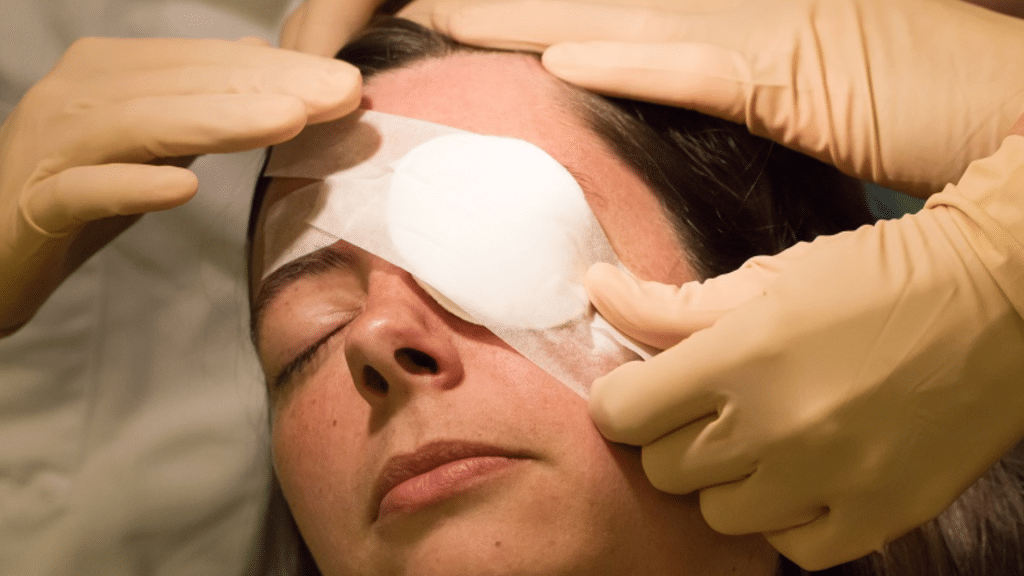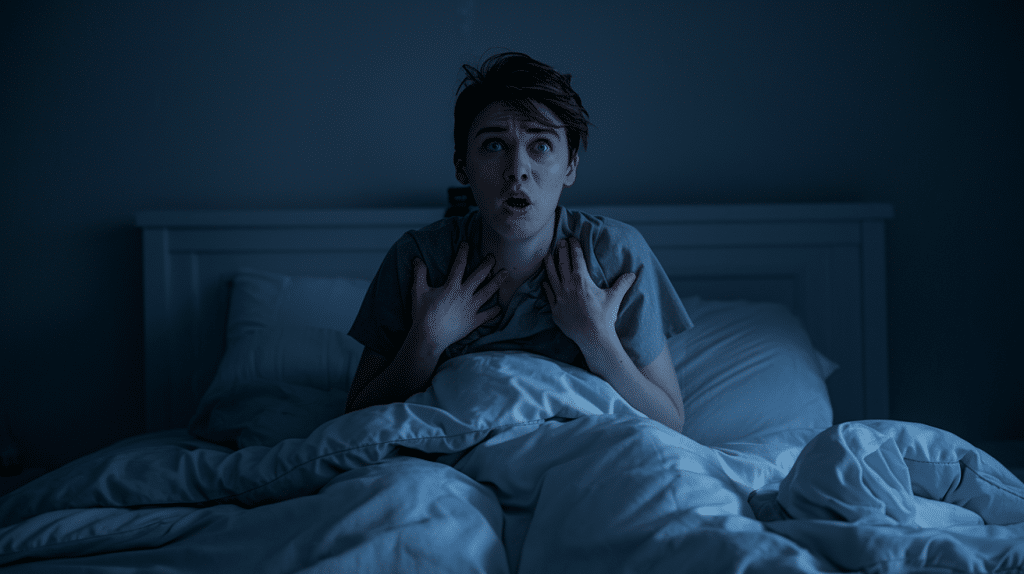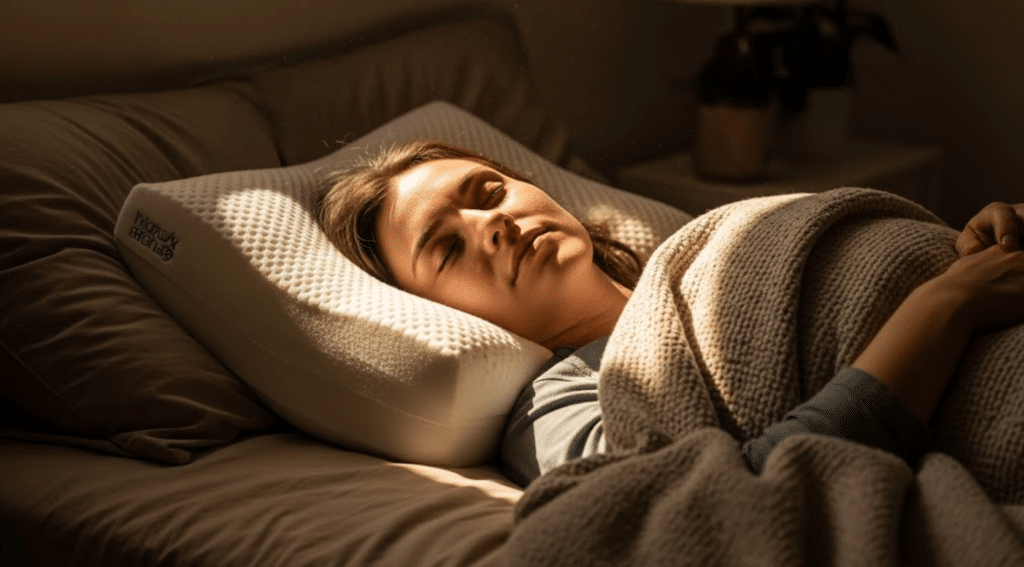It’s not easy to fall asleep when you’re worried about damaging your eye. You want to rest, but part of you keeps checking if your position is safe, or if you’re making healing harder without knowing it.
When I needed answers, I found out that even small changes made a big difference. Knowing the safest sleeping position after cataract surgery helped me feel calmer and more in control at night.
If you’re feeling unsure about how to sleep without messing up your recovery, I’ll walk you through what helped me rest easier. Want to feel more confident at bedtime?
What is Cataract Surgery and Why Sleep Matters
Cataract surgery is a quick outpatient procedure where the cloudy lens in your eye is removed and replaced with a clear artificial one.
It’s a safe and common treatment that helps improve vision, but the healing process still requires care. Your eye is sensitive right after surgery. If you apply pressure, rub it, or let fluid build up, it can slow healing or cause problems.
That’s why your sleeping position matters. How you rest at night can either support recovery or increase your risk of irritation. Sleeping the right way protects your eyes and helps you heal more comfortably.
Safest Sleep Position During Eye Recovery
Sleeping the right way protects your eye while it heals. The best sleeping position after surgery is on your back with your head supported.
1. Sleep on Your Back

Lying on your back keeps all pressure off the operated eye, which helps protect the surgical site while it heals. It also lowers the chances of accidentally rubbing or bumping your eye while you sleep.
This position gives your body the best chance to rest without disturbing your recovery. Use extra pillows at your sides if you tend to roll over during the night. Try to stay flat and calm while falling asleep to avoid unwanted movement.
2. Keep your Head Improved

Raising your head with a wedge pillow or adjustable bed can help reduce swelling around the eye.
Improvement helps with fluid drainage and keeps pressure from building up overnight. This small change also improves overall sleep comfort.
Try stacking two firm pillows or using a specialized incline pillow made for surgery recovery. Make sure your neck and back feel supported. The goal is to stay slightly upright without putting your head or face in awkward positions.
What to Avoid While Sleeping
Some sleep positions can slow healing or cause problems. It’s important to avoid pressure, contact, or twisting during sleep.
Don’t Sleep on the Operated Side
Sleeping on the side where surgery was done puts direct pressure on your healing eye. This can disturb the surgical site or shift the new lens. It also increases the risk of swelling, discomfort, or delayed healing.
Even light pressure from a pillow or blanket can create problems. Try placing a body pillow beside you to stop yourself from rolling onto that side at night. Staying mindful of your position helps protect your eye while you rest.
Avoid Stomach Sleeping
Lying on your stomach raises the chances of rubbing your eye against a pillow or mattress. This position also makes it harder to keep your head properly elevated, which can cause fluid buildup and swelling.
Plus, stomach sleeping twists your neck and face in ways that may add pressure around the eye. During the healing period, it’s best to avoid this habit completely. Stick with back sleeping to stay safe, even if it feels unfamiliar at first.
Protective Measures at Night
Keeping your eyes safe during sleep is just as important as what position you choose. Small adjustments at night can prevent accidental damage.
- Wear your eye shield every night as directed
- Secure the shield properly so it doesn’t slip while sleeping
- Use extra pillows to limit movement or turning
- Avoid sleeping near pets or young children who may bump you
- Keep your bedding clean to reduce the risk of infection
These steps help you avoid contact, pressure, or rubbing overnight. With a few simple habits, you can rest comfortably and heal safely.
When Side Sleeping Might Be Safe Again
After cataract surgery, it’s safest to avoid side sleeping during the early healing phase. Most doctors recommend sleeping on your back for the first week.
Depending on how your eye is healing, you may be able to return to side sleeping after 1–2 weeks. Some people are cleared to sleep on the opposite side of the operated eye after just a few days.
Always ask your doctor before changing your sleep position. Following their advice helps lower your risk of pressure, irritation, or complications while your eye is still healing.
How to Sleep with Specific Conditions
Not everyone can sleep flat on their back. These tips help you stay safe and comfortable based on your unique needs.
If You Have Arthritis
Lying flat might be uncomfortable if you have joint pain. Using a recliner or adjustable bed can help ease pressure on your body. Add pillows for extra back and neck support.
The goal is to stay slightly upright without straining your joints. Comfort is important; find a position that protects your eyes without adding stress elsewhere.
If You Use CPAP for Sleep Apnea
Using a CPAP mask after surgery is possible with small adjustments. Make sure the straps don’t press against your healing eye. Place your eye shield on first, then put on the mask carefully.
Ask your doctor if you’re unsure about the setup. Keep everything clean and secure while you sleep to avoid any risk of irritation or leaks.
If You’re a Side Sleeper
It’s hard to change sleep habits, especially if you’re used to sleeping on your side. Try sleeping on the opposite side of the operated eye after a few days, if your doctor allows it.
Use a body pillow or wedge beside you to keep from rolling over during the night. This setup helps you stay in position without feeling forced or tense.
Healing Timeline for Sleep Adjustments
During the first 72 hours after cataract surgery, you should sleep upright on your back with your head slightly elevated. This position helps protect your eye and reduces swelling.
Around the one-week mark, your doctor may allow side sleeping, usually on the side opposite the operated eye. This depends on how well your eye is healing.
After two weeks, most people can return to their normal sleeping habits if no complications have occurred. Always follow your doctor’s advice before making changes.
Sticking to the right sleep posture during recovery helps you avoid setbacks and supports long-term healing.
Tips for Sleeping Better After Surgery
A few small habits can help you sleep more comfortably and stay on track with recovery during the healing process.
- Set up your sleep area early: Create a calm, clean space before bedtime. Keep pillows, your eye shield, and medicine close so you can relax.
- Avoid screens before bed: Bright light from phones or TVs can make it harder to fall asleep. Give your eyes a break before resting.
- Use mild sleep aids (with doctor’s okay): Only take sleep aids if approved. Some medications might affect your eye pressure or healing process.
- Stick to your drop schedule: Use eye drops exactly as prescribed. Keeping a set routine helps reduce inflammation and speeds up recovery.
Conclusion
I know how much better recovery feels when you’re not worried about sleep. Now that you’ve seen how to protect your eyes, avoid risky positions, and stay comfortable, you can rest with more peace of mind.
The right sleeping position after cataract surgery really does make a difference. If something feels off, trust yourself and adjust.
I hope this helped you feel more confident tonight. When you’re ready, take a look at a few more posts on the website. I’d love to help you through the rest of your healing.











